We may earn revenue from the products available on this page and participate in affiliate programs. Learn More ›
Shopping for a new home used to be a process dependent almost entirely on finding a good real estate agent or scanning the real estate ads in the Sunday paper. Renters had it even worse: Many real estate agents didn’t handle rentals, so relying on neighborhood-based newsprint magazines and classifieds requiring phone calls and messages just to get a peek inside was the norm. Shopping for a place to live got a little easier once the internet allowed shoppers to browse the listings at different real estate agents’ websites (slowly and frustratingly over a dial-up connection) and some rental-only websites, and the process really broke open when the closely guarded Multiple Listing Service (MLS) became available to search. Once that happened, a number of companies saw the opportunity to build fairly comprehensive search engines incorporating MLS listings and mining data from local tax assessors to provide comps and neighborhood assessments for home shoppers to skim through while they were deciding where they might like to live. Zillow was one of those sites.
As one of the leaders of the online real estate industry, Zillow is available both online and via mobile app, and its reach into the real estate market is incomparable. The depth of the data available (and the formats in which the data can be viewed) is extensive, and there are services available through Zillow for nearly every aspect of the home buying, home renting, or home selling process. Most customers will still want to find a real estate agent to work with, but they’ll be able to provide plenty of examples of the homes they like and don’t like and identify neighborhoods they’d like to consider up front, saving time and effort and resulting in a more rewarding (and hopefully swift) process of finding (or selling) a home.
See more of the best rental listing sites, best home value estimator sites, best real estate websites, and the best foreclosure sites.
At a Glance
Zillow
Pros
- High site traffic and millions of property listings
- Users can search for and post both sales and rental listings
- Handy and relatively accurate home-value comparison tool
- Information and estimated value of off-market homes available
- Customers can search for agents, inspectors, and builders
Cons
- Irregular updates to listings
Specs
- Availability: Nationwide
- Cost: Free to browse
- Search parameters: Price, beds, baths, square footage, home type, amenities, view
- Site tools: Calculators, Zestimate, property management
- Customer service: Phone and email
Our Verdict: While there are some limitations to the data Zillow can provide, it is an outstanding start-to-finish service for home buyers, home sellers, and renters—and a great tool for those who are just browsing, too. There’s a reason it’s one of the go-to real estate directories.
About Zillow
Founded in 2006, Zillow began as a simple listing service. It then grew to include proprietary Zestimates (research-based estimates of home value), rentals, agent referrals, and financing options, along with extensive resources to help home buyers, sellers, and renters navigate the process of finding a place to live with ease. In 2015, Zillow acquired Trulia, one of its primary competitors, and formed the Zillow Group. It remains the largest organization in the industry, and thus has a lot to offer home shoppers—but this dominance also means the company doesn’t have to be as attentive to the needs of smaller groups of customers. So while there are many, many great features, there are also some potential drawbacks that customers can experience with larger entities.
What Zillow Offers
Zillow promises to assist home buyers, home sellers, and renters in navigating a smooth and successful process by encompassing all of their needs in one easy-to-use source. The company promises that customers will find listings and resources that aren’t available elsewhere, and it offers a free account to help customers keep all of their searches and applications in one convenient location.
Signing Up for a Zillow Account
Zillow does offer a free account, but for those who are casually browsing it’s not necessary. For serious home buyers, sellers, and renters, however, the membership provides some useful benefits and tools. For example, users with accounts can save searches rather than needing to reselect all of the options every time they want to check out what’s new, and they can give the searches titles for easy access. Users with accounts can also save their “favorite” listings, as can renters. In many cases, renters can save their favorite listings, apply online, access their lease, and make payments all through the Zillow portal. Sellers may want an account to track their home’s Zestimate prior to listing to determine an appropriate listing price, and sellers who are listing homes as For Sale by Owner will need accounts to manage their listings. The account settings allow users to manage their email and text message preferences, so there’s no avalanche of unwanted or persistent email clogging up the inbox.
Buying a Home
Home buyers were the initial target audience of Zillow, and the set of resources and options for those at any point in the home-buying process are still central to the Zillow platform. The goal is to help educate home buyers on their options, provide them with the information they need to make good decisions, and then offer tools and guidance through the process of searching for, touring, and ultimately selecting a home.
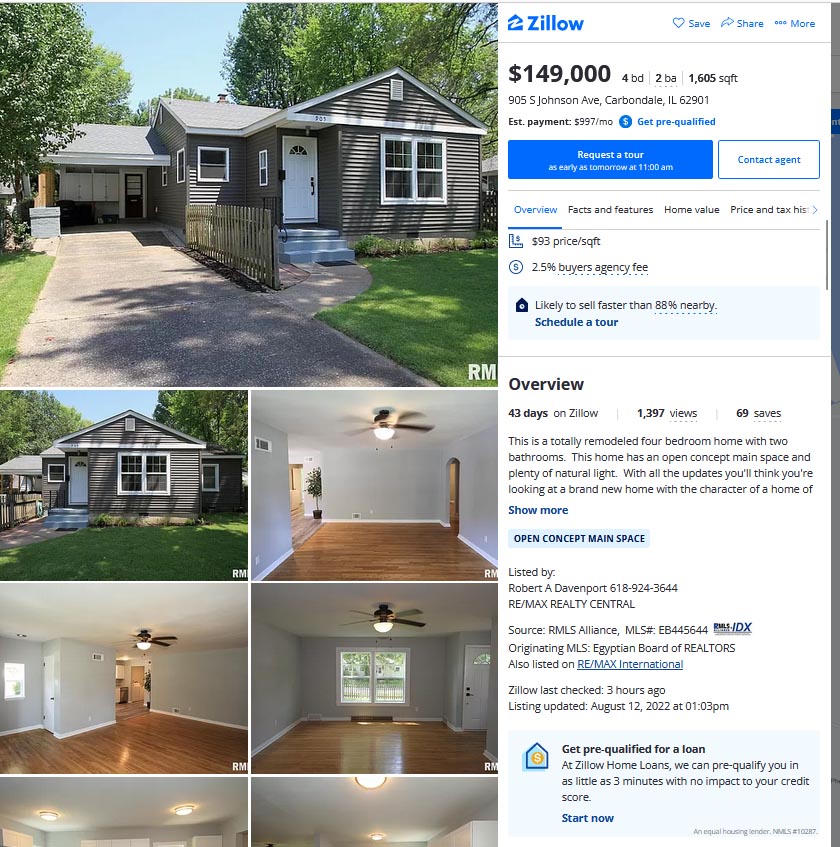
Zillow’s landing page is tailored to the user’s location. The text above the search bar invites users to “Find it. Tour it. Own it.” and requests an address, neighborhood, or ZIP code to start the search. Beneath the search bar are some options suggested as “Homes For You” with thumbnail photographs featuring homes in a range of prices. Entering a street or ZIP code brings up a satellite map of the area that users can scale with the roll of a mouse or by pinching or widening the map, with streets clearly marked. By default, homes for sale are tagged with a red balloon with the price in white text, but hovering over any building will cause a small green or gray balloon to pop up with basic information about the number of bedrooms, bathrooms, and an estimated value. This is useful because the price of the houses for sale doesn’t really give a buyer a sense of the neighborhood: Many real estate agents suggest that buyers choose the worst house in the best neighborhood; this way any improvements will directly increase the value of the home, and homeowners will be less likely to improve the home to the point that the value of the home exceeds the typical value of the homes in the neighborhood. Zillow’s price estimates and basic info, which sometimes includes photos from a previous listing or just the information available from publicly accessible property records, make it easier for buyers to get a sense of the neighborhood.
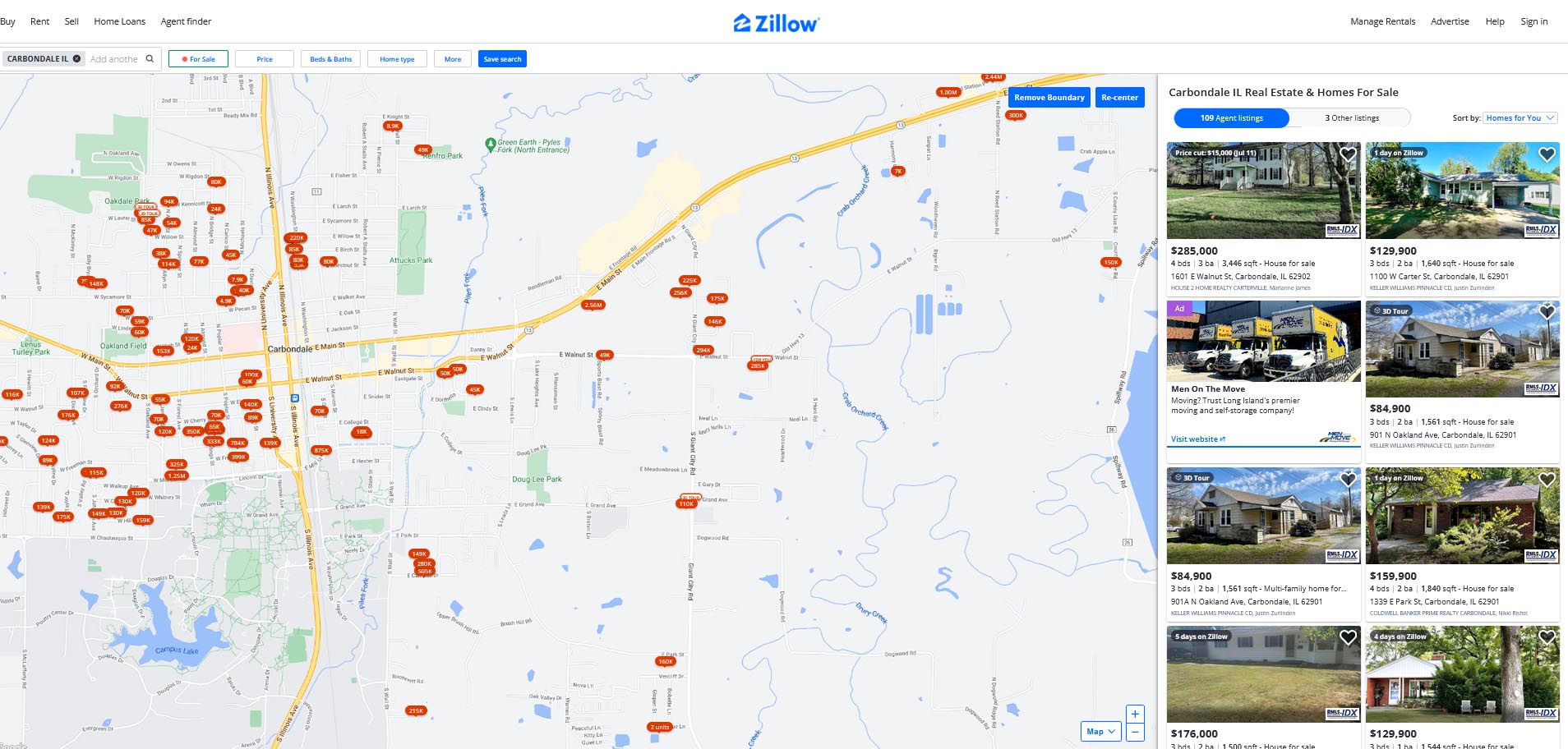
Another helpful tool for home buyers is the ability to look at homes that have recently sold. A quick click on a toggle button in the header will reveal yellow balloons on homes that have recently sold. Clicking on the balloons brings up the sale price, date of sale, and any photos that are available, along with comparable listings in the area. This can help a buyer note whether a neighborhood is in flux, having recently experienced a lot of turnover, and it can help a buyer ask a real estate agent the right questions: Is the turnover likely because a lot of the homes were occupied by original owners who are aging out of independent living, so the neighborhood is changing to a younger demographic? Or has the new restaurant district nearby created great energy but also a lot of late-night music and on-street traffic, so residents are fleeing?
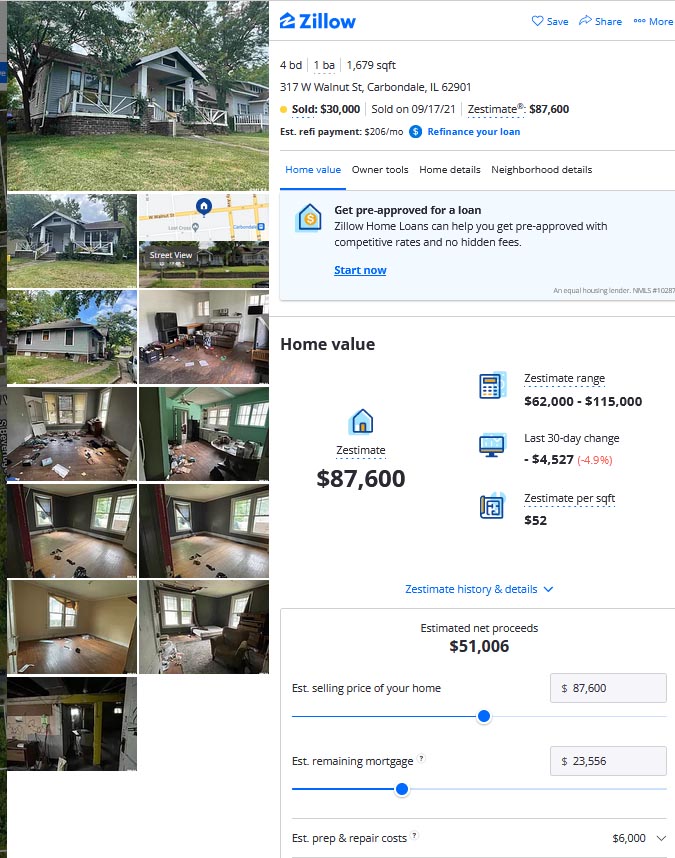
Clicking on a home that is for sale will bring up the home’s MLS listing, including the address, number of bedrooms and bathrooms, square footage, and cost. The price and tax history are included when available, along with all of the interior and exterior features of the home. Buyers can see how long the home has been on the market and can track the price changes during the listing period, which can help a buyer understand whether the seller may be willing to negotiate the price. The listing includes links to schedule tours with local real estate agents (some even include the closest time when a tour might be available) and a button to click to contact an agent.
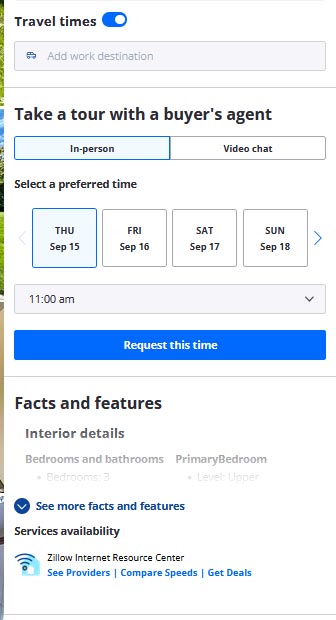
Beyond the listings themselves, Zillow provides pages and pages of resources to help buyers understand what they’re looking for, how different features may affect the cost of the home, and strategies for making competitive offers, along with red flags to watch out for. Experienced home buyers will find many of the features on Zillow intuitive and easy to use, and first-timers will find that the platform makes a process that can be intimidating a little more accessible.
Selling a Home
For sellers, Zillow also offers a balanced combination of resources and education. The Sellers Guide, accessible from the “Sell” link on the top bar, provides a selection of articles addressing the timing of sales, strategies for selling in a buyer’s or seller’s market, real estate agent selection tips, and help making decisions about what repairs to make before listing a home. In addition, Zillow provides a detailed guide for first-time sellers, explaining the intricacies of the home-selling process. Another page guides sellers through handling offers, the closing process, and preparing to move. Most important for many sellers is the landing page for sellers, on which Zillow lists the pros and cons of working with an agent versus the pros and cons of a For Sale by Owner sale. Options to find an agent near you, or to find a participating Zillow Premier Agent partner (agents who have registered with Zillow and may offer reduced listing fees and priority placement on Zillow) near you, are offered with search bars.
It’s worth noting that many of the tools aimed at buyers are also useful for sellers. Checking the sale prices of recently sold homes in the area and listing prices of homes currently on the market can help sellers more accurately estimate how much they can expect to reasonably ask for their homes.
Those who are selling their homes For Sale by Owner (FSBO) without the help of an agent can list their home for free on Zillow. These listings include unlimited photos, videos, and listing details, and will be posted on both the Zillow and Trulia platforms for an exceptionally large audience. When new FSBO listings are posted, shoppers whose saved searches match the listing will receive an email with the new listing, providing a targeted audience with marketing materials for the home at no cost to the seller. While selling a home without an agent can be a tricky process to navigate, Zillow’s listing service is a great option for sellers to get information about a home for sale into the hands of potential buyers.
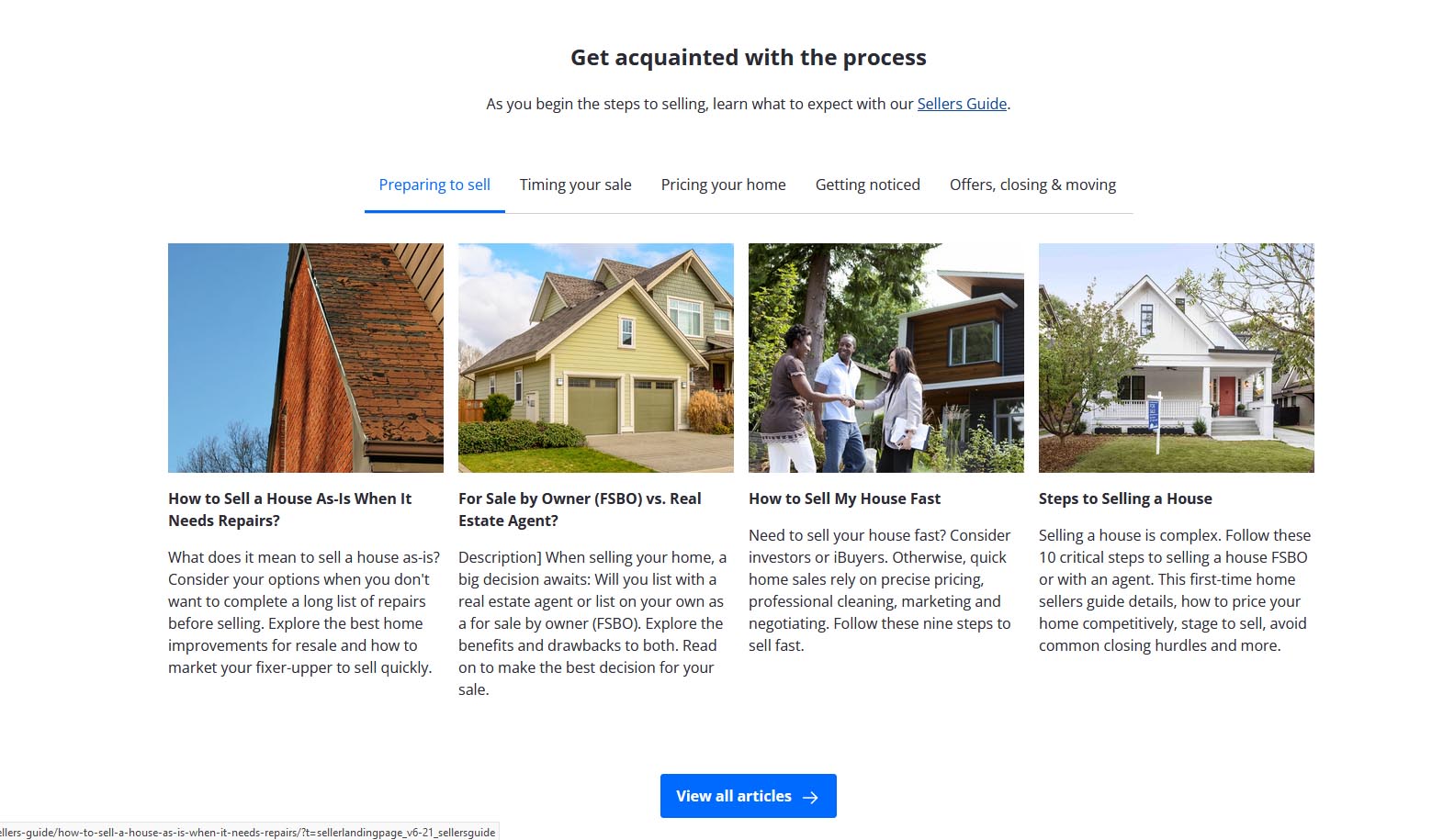
Renting a Home
Renters are often overlooked by traditional home sale sites and real estate agencies. Renters don’t bring in big commissions for agents, and often require more work on the part of the agents. Zillow has addressed this gap in services by dedicating an entire segment of its platform to helping renters educate themselves about different types of rental units, decision-making strategies, rental agreements and leases, budgeting, and searching for a rental home. A page titled “Ready to Rent? Start Here!” presents articles on the basics of the rental process, finding the right rental, and making a rental into a unique and comfortable home. The page is neatly laid out, with articles broken into categories and organized in a clear and accessible order to guide renters through the process from start to finish.
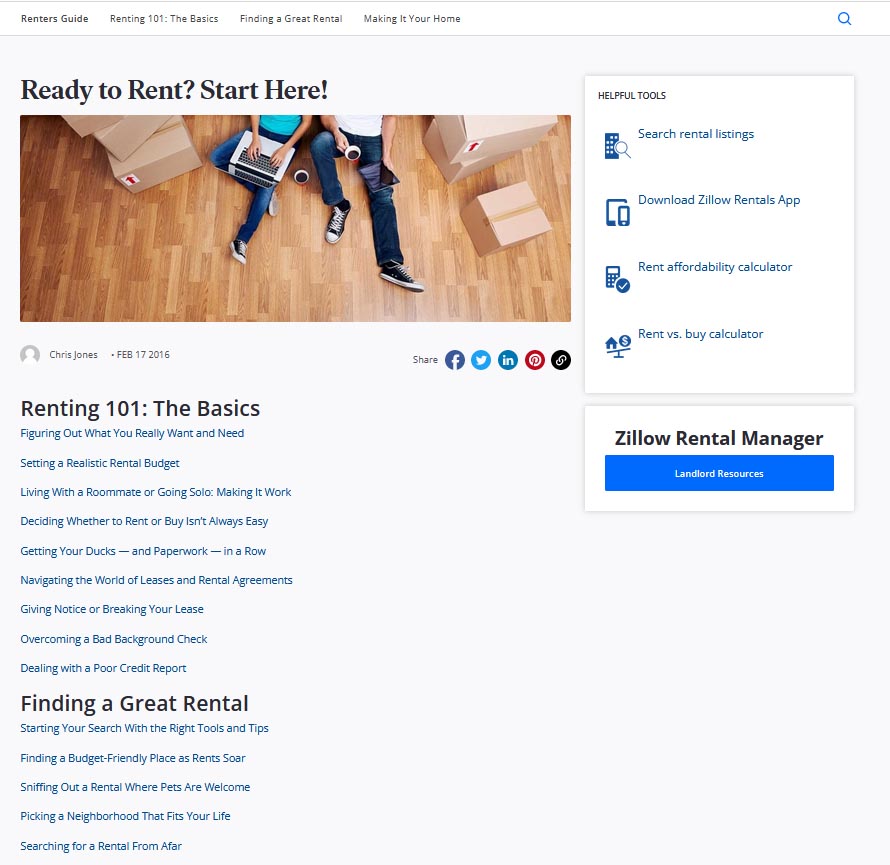
Searching for rental listings is simple: Renters can simply input the town, address, or ZIP code where they’d like to search, and the same map that home buyers see will populate. The toggle switch on the top bar of the map that allows buyers to switch between homes for sale and homes recently sold also offers a “For Rent” option, or renters can click a link to find rental listings. Single-unit rentals are noted with a light-purple balloon with a price listed, while multiunit listings are highlighted by a darker-purple balloon noting the number of units for rent. Clicking on a listing populates an information sheet with the name of the unit, address, monthly rental costs, and features and amenities (including pet-friendliness, laundry services, bicycle storage, parking, and lease terms). Renters can request a tour directly from the listing, and they can also choose to apply for the rental unit by entering contact information, which will then be transmitted to the rental agent or management company who will then send appropriate paperwork and information.
Once the map is populated, renters can narrow their search using buttons at the top edge of the map: The price, number of bedrooms and bathrooms, home type, and available move-in dates are quick limiters, and the “More” button allows renters to sort the listings by amenities such as pools, on-site parking, air conditioning, and number of stories. Renters who prefer to keep their entire rental process in one place can choose to see only properties that accept applications via Zillow’s platform. The Renter Hub allows those with Zillow accounts to keep track of rental units they’ve contacted or applied for, and once a lease is signed, the details can be saved to the account. Some rental units accept monthly rent payments through the Zillow platform as well.
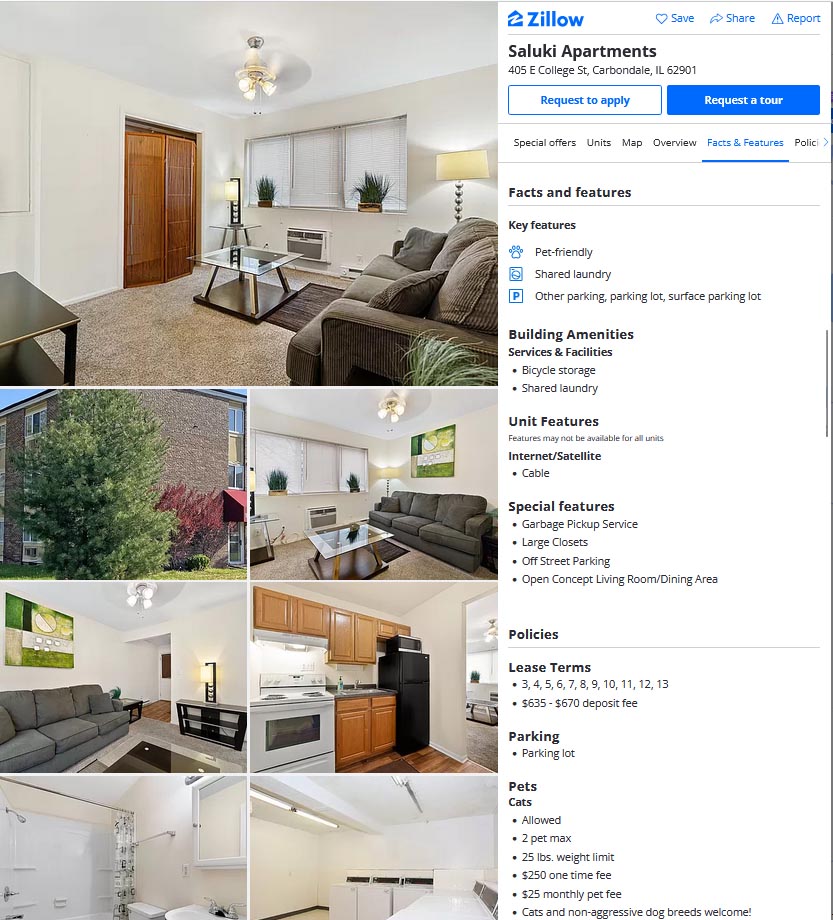
Zillow Home Values: Zestimates
Zillow’s presence in the home buying, selling, and renting industry is significant because of its sheer size and dominance, but one of its greatest successes is the Zestimate. Zillow has developed a proprietary formula that draws on data from publicly available tax and assessment records, MLS listings, nearby comparables, and user-submitted data to create a valuation for a property. This is not the same as an appraisal, because while Zestimates are some of the most accurate (nationally, the median error rate is only 3.2 percent), they cannot incorporate information they don’t have. For example, a Zestimate might be primarily based on a recent home sale, but if the owner has made significant improvements in the home that did not require a permit, the tax assessor’s office won’t necessarily know the status of the interior and may undervalue it significantly as a result. However, with approximately 1.4 million homes listed with Zestimates on the website, 89.6 percent are sold at a price that falls within 10 percent of the Zestimate, and 67.2 percent have a Zestimate within 5 percent of the sale price. While the Zestimate formula isn’t known outside of Zillow, it’s consistent and allows buyers, sellers, and renters to compare one home with another on an even scale to determine which is the best value.
Zillow Agent Finder
Another Zillow service offered to home buyers, home sellers, and renters is the Agent Finder, and there are two categories of agents that can be searched. The first category is the basic Agent Finder, which will locate registered real estate agents in the area of the selected town or ZIP code. Entering a local ZIP code will result in the photos and contact information for many agents that users will recognize from local advertising. The other category is the Zillow Premier Agent finder. Zillow Premier agents are those who have registered with Zillow and paid a fee to receive notifications of new listings and advertising on Zillow. All fees and costs incurred by the customer are determined by the agents; they do not work for Zillow, but they have chosen to partner with Zillow as a business feeder stream.
Does it help customers? Not necessarily. It won’t hurt them, but a Zillow Premier Agent membership is primarily for the benefit of the real estate agent for the purpose of earning money from additional leads and advertising.
Zillow Home Loans
Zillow’s most recent foray into expansion is the addition of home loan applications and servicing directly through the Zillow website and app. Zillow offers links to loan officers to finance home purchases and also to refinance currently held mortgages or home loans. Customers are asked where they are in the process of the home-buying process, then matched with an appropriate loan officer after they answer a series of questions about the type of loan, type of home, ZIP code, and residency. Users are also asked to estimate their planned budget and down payment. Other questions ascertain what special loan programs a customer might be eligible to invoke, such as a VA home loan.
The Zillow Home Loans page, consistent with the other landing pages throughout the site, also offers educational materials about the different types of loans available to buyers through this service, such as conventional loans, FHA loans, and VA loans, along with the basic parameters of each type and sample loan terms pages. The information provided is straightforward and clearly explained, and it simplifies a process that can otherwise be onerous and overwhelming. Articles about rate research, closings, and credit scores help buyers prepare for the process and offer tools that buyers will need along the way, and a slew of calculators (monthly payments, affordability, refinancing, and others) and rate comparisons support the idea that the company is honestly trying to help buyers get the best deal. Zillow’s own rate comparison tool helps readers see that its rates are reasonable; while they aren’t necessarily the lowest rates, having the integrity to acknowledge that several other companies’ rates were lower than Zillow’s provides its marketing strategy with a certain amount of veracity.
Buyers can conveniently prequalify for a loan directly through the website or app.
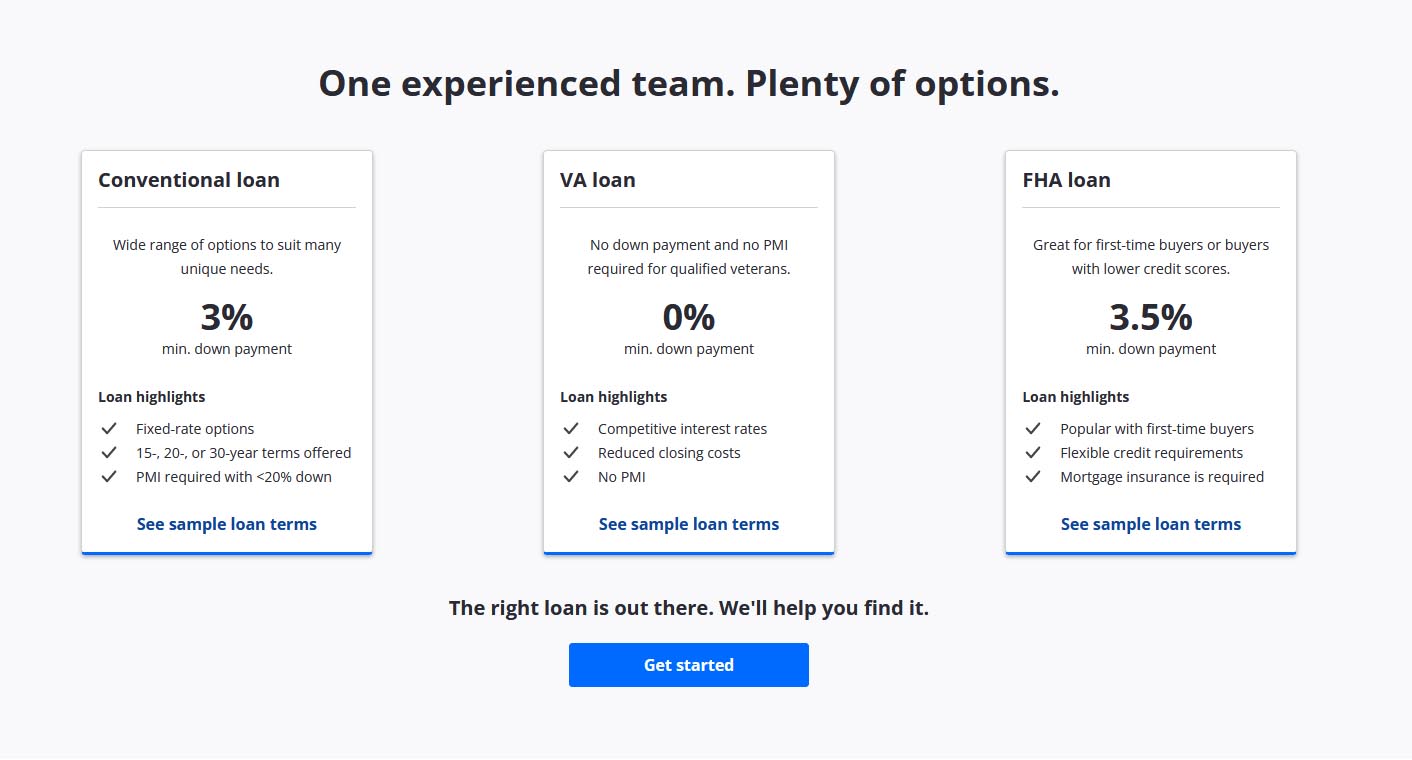
Zillow’s App
Zillow’s app is available for Apple and Android devices. It is comprehensive and fully featured, offering opportunities to like and share listings, see a lease agreement and make payments, and manage rental units. The app is also a surprisingly clean and powerful interface; photos load quickly and completely, and details are readable even on a smaller screen. Android phones have some slight limitations, especially for sellers or landlords, in that photos can’t be uploaded on an Android phone. Otherwise, the app does just about everything the website does, only in the confines of a pocket or purse.
Zillow Offers
While most current users search Zillow to find out how much buying a home will cost, for several years “How much does Zillow charge to buy your house?” was a reasonable question. The now-defunct Zillow Offers was a popular program that suffered from some flaws that turned out to be unsustainable, but it still turns up in articles online when users are searching for Zillow programs. How does Zillow Offers work, and is selling your home to Zillow a good idea? Well, unfortunately, it doesn’t work, because it wasn’t worth it for Zillow. Zillow purchased homes from sellers who couldn’t wait for a buyer, or who wanted a quick and easy sale. Zillow would make an offer on a home, and, if accepted, buy the home, then handle any repairs or upgrades and resell it for more money. Unfortunately, Zillow cash offers were often too high, so the money made after repairs and resale wasn’t sufficient to make the investment worthwhile. Zillow Offers fees were thought to be too high in some cases.
Is Zillow Offers a good deal? For many sellers, it was, as a quick search for “selling to Zillow reviews,” “selling your home to Zillow reviews,“ “are Zillow Offers fair,” and “is selling your house to Zillow worth it” reveals. While the 7.5 percent fee charged by Zillow as part of the deal was steeper than standard commission, the prices offered were comparable to what home sellers would expect—except the sellers didn’t have to cope with repairs and cleanup before selling. They just had to move out, making the fee seem much more reasonable. A search for “Zillow owned homes reviews,” “Zillow offers homes for sale,” and “Zillow home purchase reviews” shows that purchasers of Zillow Offers homes were satisfied with the quality of their purchases. The cost of the homes plus the cost of repairs and sales simply outstripped the amount Zillow could reasonably charge for the homes once they were ready to sell, and because the program wasn’t widely available nationwide, Zillow discontinued it in November 2021.
Other Resources
Zillow Offers may be a thing of the past, but Zillow 360 is a current program that can result in significant savings. For customers who need to sell one home and buy another, making the decision to sell, buy, and finance through Zillow results in a $1,500 closing credit, a 1.5 percent cash rebate from Zillow, and potentially other discounts on real estate commission charges. Should the customer choose to buy and finance a home through Zillow, they can claim a closing cost credit equivalent to 0.6 percent of the loan amount. To qualify, buyers must use a Zillow Premier Agent partner to purchase the home and finance through Zillow Home Loans. Zillow 360 is currently offered in limited markets, but the program continues to expand, so check to see if it’s an appropriate option when the time comes to buy or sell a home.
Zillow Testimonials and Reviews by Customers
Customer reviews for services such as Zillow are always tricky to interpret because there are so many facets of Zillow’s platform that rely on accurate information being transmitted via MLS and other services, and on landlords and agents doing their jobs ethically and well. Zillow draws on MLS and on local property records and tax assessments to render their Zestimates and post photos and information, but it does not (and, realistically, could not) vet all of that information to ensure accuracy. Zillow notes that Zestimates are estimates based on known information and also clearly notes that self-posted rental listings and real estate agents are not subject to vetting or verification. Many of the Zillow complaints at sites such as Trustpilot focus on real estate agents who customers feel have not measured up, landlords who haven’t been fair, or the listing prices asked by sellers and merely posted by Zillow. These complaints reflect poorly on the process, but not on Zillow itself, though it does suggest a market for formal Zillow Realtor reviews. The Better Business Bureau has opted not to accredit Zillow due to the number of similar complaints about its rental listings. While Zillow does respond promptly to customer complaints at BBB, quite a few customers don’t accept the resolutions, in part because they hold Zillow responsible for inaccurate information posted in their listing that was drawn from another source. While the misinformation may not be Zillow’s fault directly, the number of complaints of this type does suggest that the company could adjust its Zestimate algorithm slightly and perhaps consider a screening process for real estate agents it recommends.
How Zillow Stacks Up to the Competition
Because Zillow’s range of services is so extensive, it’s difficult to do a real apples-to-apples comparison. Zillow’s Zestimates, in general, are more accurate than Redfin’s estimates—but Redfin uses a team of vetted, in-house real estate agents to serve its customers, while Zillow refers customers to agents who are licensed and reviewed by customers, but performs no vetting itself. This is a risk, as customer complaints about the real estate agents they found via Zillow make up a significant portion of Zillow’s negative reviews online; quite a few complaints mention the absence of Zillow real estate agent reviews or Zillow reviews for agents, noting that where Zillow includes any reviews of its agents, they’re always from customers. Many competitors, such as Apartments.com, Realtor.com, HomeSnap, and others, provide one or two components of the home search and purchase process and provide those services exceptionally well with more attention to detail and verification than Zillow does, but the enormous benefit of Zillow is that it’s all in one place, on an app or on a home computer. Customers looking for boutique or concierge service may prefer one of the smaller competitors, while Zillow is better suited to those who want the whole home-buying, home-selling, or home-renting purchase contained in one place.
Should You Use Zillow?
Is Zillow legit? For customers who are browsing homes and dreaming of the future, Zillow is a fantastic service because of the wide range of properties featured with reasonably up-to-date information. Renters and buyers who are actively searching for a home will find that Zillow provides them a bevy of homes to tag or share with a real estate agent during the search, along with a lot of useful articles, calculators, and guides to help make the dream home a reality. A simple, robust interface supports a significant catalog of information with an easy search platform to create a strong candidate for one-stop-shopping. Users must bear in mind that the information is as up to date as possible, but not necessarily perfect, and that Zestimates aren’t precise figures and are based on the available information. With those caveats in mind, Zillow is a great choice to use to find and finance your next home and sell the current one.
We independently reviewed this service by weighing the company’s claims against first-hand experience with its professionals. However, due to factors such as franchising, human error, and more, please note that individual experiences with this company may vary.



